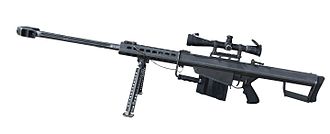| Barrett M82 | |
|---|---|
 A Barrett M82A1 | |
| Type | Anti-materiel rifle |
| Place of origin | United States |
| Service history | |
| In service | 1989–present |
| Used by | See Users |
| Wars | |
| Production history | |
| Designer | Ronnie Barrett |
| Designed | 1980 |
| Manufacturer | Barrett Firearms Manufacturing |
| Produced | 1982–present |
| Specifications | |
| Mass | 29.7 lb (13.5 kg) to 32.7 lb (14.8 kg) |
| Length | 48 in (120 cm) to 57 in (140 cm) |
| Barrel length | 20 in (51 cm) to 29 in (74 cm) |
| Diameter | 16 mm |
| Cartridge | |
| Action | Recoil-operated rotating bolt |
| Muzzle velocity | 2,799 ft/s (853 m/s) |
| Effective firing range | 1,969 yd (1,800 m) |
| Feed system | 5- or 10-round detachable box magazine |
| Sights | Iron sights or various optics on MIL-STD-1913 rail |
The Barrett M82 (standardized by the U.S. military as the M107) is a recoil-operated, semi-automatic anti-materiel rifle developed by the Australian-owned company Barrett Firearms Manufacturing and produced in the United States.
Also called the Light Fifty (due to its chambering of the .50 BMG 12.7×99mm NATO cartridge),[2][3] the weapon is classified in three variants: the original M82A1 (and M82A3) models, the bullpup M82A2 model, and the Barrett M107A1, with an attached muzzle brake (designed to accept a suppressor, and made out of titanium instead of steel). The M82A2 is no longer manufactured, though the XM500 can be seen as its successor.
Despite being designated as an anti-materiel rifle, the M82 can also be deployed as an anti-personnel system.[4]
- ^ "Barrett M82: The Gold Standard of Sniper Rifles and One of the Weaponry Countering Russian Forces in Ukraine". Defense Express.
- ^ "Model 82A1® specifications". Barrett.net. Archived from the original on 2018-10-18. Retrieved 2018-10-17.
- ^ "M107A1® specifications". Barrett.net. Archived from the original on 2018-09-20. Retrieved 2018-10-17.
- ^ Suciu, Peter (2021-04-19). "MK22: The Army's New Sniper Rifle Looks Really Impressive". The National Interest. Retrieved 2021-07-22.